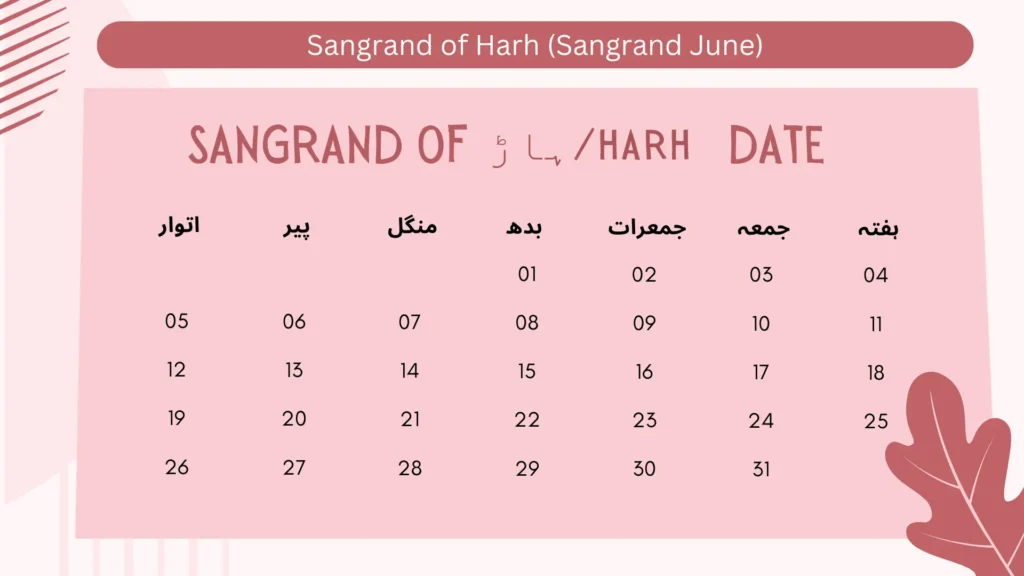Sangrand of Harh in the Month of June According to the Nanakshahi Samvat Calendar
On the 15th of June is the day of (ਸੰਗ੍ਰਾਂਦ – beginning of the month) Sangrand of Harh (ਹਾੜ – a month in the Punjabi calendar). Sangrand is the changing of the month, and we are not necessarily worshipping the month. Still, we are taking the teachings of the month as Gurusikhs (ਗੁਰੂਸਿਖ – disciples of the Guru). From the Guru’s times, people would do Sangat (ਸੰਗਤ – congregation) at the changing of the month. As Gurusikhs would get together, that would be how they would celebrate in the old days—celebration through Sangat. When they would do the Sangat, Guru Sahib Ji would give them Updesh (ਉਪਦੇਸ਼ – teaching) for that month.
You can view the list of all Sangrand dates for each month in the current year. You can also see the English calendar dates for Sangrand in January, February, March, April, May, July, August, September, October, November, and December for the current year.

Teachings of Guru Arjan Dev Ji During Sangrand of Harh
Sahib Sri Guru Arjan Dev Ji, who has blessed us with the Bani (ਬਾਣੀ – sacred text) of Barah Maha (ਬਾਰਹ ਮਾਹਾ – the twelve months), in the Raag Maajh (ਰਾਗ ਮਾਝ – a musical measure), teaches us: The Concept of Asaaradh (Harh)
Asaaradh (ਅਸਾੜ੍ਹ) the Pandat (ਪੰਡਿਤ – learned person) this Lagai(ਲਗਾਈ – attaches), Her Naho (ਹੇਰ ਨਾਹੋ – without the Lord) Nahin Na Paas (ਨਹੀਂ ਨ ਪਾਸ – are not near).
Asaaradh is the name of the month. That word has developed through time and is now known as Harh (ਹਾੜ – summer month). Harh da Mahina (ਹਾੜ ਦਾ ਮਹੀਨਾ – the month of Harh) has developed from the word Asaaradh. In the olden days, the month was called Asaaradh. Theialects moved forward, and as the language evolved, the name became Harh. But in Gurbani (ਗੁਰਬਾਣੀ – Sikh scriptures), we call it Asaaradh, and we respect the words used by Guru Sahib Ji themselves.
The Significance of Harh/Asaaradh
So During the Sangrand of Harh and in this month of Harh/Asaaradh, Tapanda (ਤਪਦਾ – burning) means to burn, to feel the heat, that stuffiness, to feel the heat inside, to burn from within. This Lagai (ਤਿਸ ਲਗਾਈ) refers to those who feel the burning within themselves in this month of Asaaradh.
Her Naho (ਹੇਰ ਨਾਹੋ) – Her here means husband, the husband Lord, Wahiguru(ਵਾਹਿਗੁਰੂ – God), the Almighty Husband Lord. Because we are all soul brides of Akal Purakh Wahiguru (ਅਕਾਲ ਪੁਰਖ ਵਾਹਿਗੁਰੂ – the timeless being, God), they are our husband, Lord. Her Naho– our husband Lord, Akal Purakh Wahiguru. Nahin Na Paas – those who are separated, who have lost the realization, who are not experiencing their husband Lord Akal Purakh Wahiguru in this month of Asaaradh, now known as Harh, feel burning from within. That is the teaching Guru Sahib Ji is giving us. They use the example of a husband, Lord.
The Example of Separation
We know any wife who is separated from her husband will feel burning and anguish from within, not knowing where her husband is, not feeling that love from her husband. Guru Sahib Ji uses the example of a wife being separated from a husband she truly loves and is devoted to. A wife who truly loves her husband and has a true passion for him, when that husband is separated from her even for an instant, feels anguish within, pain within, enduring separation.
Because she has a genuine love for her husband, and that is the type of love, an even greater love, that we should have for Akal Purakh Wahiguru. When, during those times that we are separated from them and don’t realize that they are with us, we are not experiencing them, and we should feel that anguish too.
Materialism and Spiritual Yearning During the Sangrand of Harh
Guru Sahib Ji is saying that those who are separated from their husband Lord, Akal Purakh Wahiguru, in this month of Harh, in the Gurbani, because the old way of saying this word was Asaaradh, are the ones who feel genuine anguish, the actual burning within. This month of Harh is during the summer months; in summer, we always feel hot, stuffy, sweaty, and burning from within. But Guru Sahib Ji is saying that only those separated from their husband Lord think that the anguish, tension, suffering, and burning from within themselves is heat from within.
Understanding Aas During the Sangrand of Harh
So, if we take the transition of Asaaradh a little bit further, Aas (ਆਸ – hope) means to want, to yearn for something. If we are yearning for worldly wealth, because living in this world, we all have that thought sometimes, that wish, that want, that desire to develop materialistically, and we want more materialistic wealth to create—whether that’s in the form of clothes, cars, houses, status, or money—and we look out for this and have that yearning, that desire to develop materialistically.
The Impact of Material Desires
Guru Sahib Ji, if we take a more profound translation from the word Asaaradh, in this month of Asaaradh and during the Sangrand of Harh, if we have that Aas, that yearning, that desire, the desire for materialism, we will be separated from our husband, Lord. Because that love will be directed towards materialism and the development of materialism rather than towards our husband, Lord, and thus, we will be separated from them. Because that love will not be focused on them; it will be elsewhere. If that love is elsewhere, we will feel the burning within ourselves.
Focus on Devotional Worship During the Sangrand of Harh
Guru Sahib Ji, giving us that example, tells us that our focus and attention in this month of Asaaradh (Sangrand of Harh) should only be towards Akal Purakh Wahiguru. That focus and attention should be through true devotional worship and true devotional love. Suppose we show that true devotional love to Akal Purakh Wahiguru.
In that case, we will not be separated from them because we can experience them. When we encounter them, we won’t feel that burning, that anguish, that torture from within because the love will not be directed towards materialistic development; it will be towards oneness with our Guru, Akal Purakh Wahiguru.
Guru Arjan Dev Ji’s Teachings During Sangrand of Harh
Sahib Sri Guru Arjan Dev Ji, in this month of Asaaradh (Sangrand of Harh), is giving us the teaching that those who have lost their love for Akal Purakh Wahiguru and only have desires for materialistic development in this summer month of Asaaradh, which is already hot, will be separated from the husband, Lord Akal Purakh Wahiguru. They will not be able to experience them because their focus and attention will be on materialism, and because of that reason, they will feel anguish and burning, torture and tension from within.
Conclusion
Therefore, we should entirely focus on Akal Purakh Wahiguru so we don’t have to feel that anguish, tension, and burning from within. These are the teachings that Sahib Sri Guru Arjan Dev Ji gave us During the Sangrand of Harh (ਸੰਗ੍ਰਾਂਦ – beginning of the month). This month is the turning of the Sangrand of Harh.
As I said, as the language has developed, we now call this month Harh rather than Asaaradh. Guru Sahib Ji has given that teaching. Let us hope and pray we can follow that teaching and understand it so we are not separated from our husband, the Lord; we show true devotional love to Akal Purakh Wahiguru and renounce all materialism. Then we will find that peace, that Anand(ਆਨੰਦ – bliss) from within.
